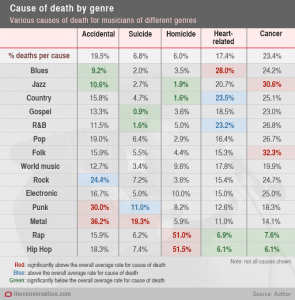Music to die for: how genre affects popular musicians’ life expectancy
向乐而死:流派如何影响流行音乐家的预期寿命
 相较于性别或年龄,音乐流派与不同类别的致死原因联系更为紧密。供图:Surian Soosay, CC BY-SA
相较于性别或年龄,音乐流派与不同类别的致死原因联系更为紧密。供图:Surian Soosay, CC BY-SA
Do all popular musicians live hard and fast, take risks and die young?
是否所有的流行音乐家都发奋求存,飞逝人生,率性冒险,英年早逝?
This article is the third in a series examining mortality in popular musicians.
此文为流行音乐家死亡调查系列之三。
To recap, the first article examined longevity, suicide, murder and accidental death rates in pop musicians compared with population data from the US. As expected, longevity was significantly reduced in pop musicians, who also had higher rates of suicide, homicide and accidental death.
概述前作,系列中的第一篇调查了流行音乐家的寿命、自杀率、他杀率和意外死亡率并与美国人口的平均数据相比较。不出所料,流行音乐家的寿命大大低于全美人均寿命,并有着更高的自杀率、他杀率和意外死亡率。
The second article explored the “myth” of the so-called 27 club, explaining how this idea emerged and why it has taken root in the public imagination.
系列之二则探究了所谓的27岁俱乐部的传说,解释了这个概念是如何形成的,以及为何它得以扎根于公众的想象中。
In this article, I’d like to look at whether membership of different music genres is associated with different risks of early death and different causes of death.
在此文中,我会看看,音乐家所属流派的不同,是否与不同的早逝风险以及不同的死因相关联。
The chart below plots genres over time (oldest to youngest genres), showing the average age of death of popular musicians by genre and gender against life expectancy (LE) for US males and females born in the same year.
下图将音乐流派依时序排列(从最早的类型到最新的),显示了不同流派不同性别的流行音乐家的平均死亡年龄,以及同年出生的美国男性和女性的寿命预期。
Musicians from the older genres – blues, jazz (including bebop and dixieland), country (including country and western, boogie woogie, honky tonk and bluegrass), and gospel (including spiritual and Christian rock) – enjoyed, on average, similar lifespans as those from the US population with the same year of birth and gender.
那些属于较早期的音乐流派——蓝调、爵士(包括比波普和迪克西兰)、乡村乐(包括西部乡村、布吉乌吉、酒吧音乐和蓝草)以及福音音乐(包括圣歌和基督教摇滚)——的乐手平均拥有和同年出生、同样性别的美国大众相似的寿命。
The next group – R&B (including doo wop and soul), pop, folk (including ballad and polka) and world music – had lower life expectancies compared with the US population.
下一个群体——属于R&B(包括杜沃普和灵魂)、流行乐、民乐(包括民谣和波尔卡)和世界音乐的音乐家——与美国民众相比则寿命预期较低。
Thereafter, the gap between population lifespans and average age of death for the more recent genres – rock (including rockabilly), electronic (including experimental, techno, disco, and funk), punk, metal, rap and hip hop – widens.
此后,那些属于更新近的音乐流派——摇滚(包括山区乡村摇滚)、电子乐(包括实验乐、高科技舞曲、迪斯科和疯克)、朋克、金属、说唱和嘻哈——的音乐家们,与美国民众相比,在寿命和平均死亡年龄上的差距进一步加大。
This pattern reflects, to some extent, a confound in the data: musicians who are dying youngest belong to newer genres (electronic, punk, metal,rap,hip-hop) that have not existed as long as genres such as jazz, country, gospel and blues. Consequently, they have not had the same opportunity to live a full lifespan.
这种规律在一定程度上反映了一个数据上的偏差:那些死亡年龄最小的音乐家属于较新的音乐流派(电子、朋克、金属、说唱、喜欢)。这些流派与诸如爵士、乡村、福音音乐和蓝调等相比,存在时间较短。结果是,这些死去的音乐家们尚还没有获得同样的机会活到人均寿命。
However, this is not the whole answer.
然而,这不是全部的答案。
The main causes of death for musicians from different genres
不同流派音乐家的主要死因
The table below shows that musicians from different genres have different rates of death from different causes of death.
下表显示,不同流派音乐家死于不同死因的比例并不相同。
For male musicians across all genres, accidental death (including all vehicular incidents and accidental overdose) accounted for almost 20% of all deaths. But accidental death for rock musicians was higher than this (24.4%) and for metal musicians higher still (36.2%).
对各种音乐流派的男性音乐家整体来说,意外死亡(包括所有的交通意外和意外吸毒过量)占全部死亡的大约20%。但摇滚乐手的意外死亡率则高于此数字(为24.4%),而金属乐手则更高(为36.2%)。
Suicide accounted for almost 7% of all deaths in the total sample. However, for punk musicians, suicide accounted for 11% of deaths; for metal musicians, a staggering 19.3%. At just 0.9%, gospel musicians had the lowest suicide rate of all the genres studied.
自杀占了样本中全部死因的7%。但是,对于朋克乐手,自杀占死因的11%;对于金属乐手,比率达到令人震惊的19.3%。而福音音乐家则是调查的各种流派中自杀率最低的,仅仅为0.9%。
Murder accounted for 6.0% of deaths across the sample, but was the cause of 51% of deaths in rap musicians and 51.5% of deaths for hip hop musicians, to date. This could be due to these genres’ strong associations with drug-related crime and gang culture.
谋杀占了所有样本中死因的6.0%,但到目前为止却占了说唱音乐家死因的51%,占嘻哈音乐家死因的51.5%。这可能是因为这些音乐流派与毒品相关犯罪和帮派文化有着强烈联系。
Heart–related fatalities accounted for 17.4% of all deaths across all genres, while 28% of blues musicians died of heart-related causes. Similarly, the average percentage of deaths accounted for by cancer was 23.4%. Older genres such as folk (32.3%) and jazz (30.6%) had higher rates of fatal cancers than other genres.
与心脏相关的死因占所有音乐家死因的17.4%,而28%的蓝调音乐家死于心脏病相关的原因。相似的,癌症占各类死因的23.4%。与其它类型相比,早一些的音乐流派如民谣和爵士音乐家们死于癌症的比率更高,分别为32.3%与30.6%。
In the case of the newer genres, it’s worth pointing out that members of these genres have not yet lived long enough to fall into the highest-risk ages for heart- and liver-related illnesses. Consequently, they had the lowest rates of death in these categories.
值得一提的是,属于较新流派的音乐家们还未能活到心脏病和肝脏相关疾病风险最高的年纪。相应的,他们死于这类死因的比率也最低。
So, what can we conclude about musicians and music genre membership?
那么,对音乐家和所属音乐流派我们能得出什么结论呢?
This study highlights the different mortality profiles of musicians belonging to different genres of popular music, and cautions against treating the population of popular musicians as homogeneous.
这项研究突出了属于不同流行乐流派的音乐家们的死亡率分布的不同,并对统一对待各种流行音乐家的做法提出警告。
Music genre was associated with distinct causes of mortality, more so than gender or age (not presented here). This suggests that once someone is inducted into the popular music industry, effects of sex and age on mortality may be masked by genre “membership” and its accompanying lifestyle.
音乐流派与不同死因的相关性要超过性别或年龄与不同死因(未在此文中显示)的相关性。这说明某人一旦进入流行乐行业,性别与年龄对死亡率所起的作用可能被所属流派以及相应的生活方式所掩盖。
Importantly, because this was a quantitative study of dead musicians and our aim was to gather population data to identify occupational hazards in the pop music world, I can only speculate here about the underlying causes of these patterns in mortality.
重要的是,因为这是一项对已经死去的音乐家们的量化研究,且我们的目标是通过搜集人口数据来对流行乐界中的职业危害进行识别,我只能在这里对造成死亡率分布规律的潜在原因进行猜测。
 “性手枪”乐队的Sid Vicious,摄于1978年。次年,Vicious因服食过量海洛因死亡,年仅21岁。海洛因是他母亲弄到手的。Chicago Art Department/ Wikimedia Commons
“性手枪”乐队的Sid Vicious,摄于1978年。次年,Vicious因服食过量海洛因死亡,年仅21岁。海洛因是他母亲弄到手的。Chicago Art Department/ Wikimedia Commons
These figures likely represent a combination of factors inherent in the popular music industry (such as the ubiquitous presence of alcohol and other substances of addiction, irregular hours, touring, high levels of stress, performance anxiety) and the vulnerability that many young musicians bring with them into their profession from adverse childhood experiences. Add to this the subcultural values and philosophies in distinct music genres with which young musicians become imbued, and you have a complex, multi-faceted picture of musician mortality.
这些数字有可能代表了流行乐产业中的固有因素(比如酒精和其它致瘾物质的普遍使用、不规律的作息时间、巡回演出、高度压力、演出焦虑)与很多年轻音乐家从不幸的童年经历带入职业的脆弱性的结合。雪上加霜的还有年轻乐手们被灌输的亚文化价值观和特定音乐流派中的不同哲学。于是,你就有了一个关于音乐家之死的复杂而多面的画面。
Other studies have reported similar significantly-reduced life expectancy in popular musicians from the newer genres compared with matched general populations. Mortality rates were between two and three times higher for popular musicians than matched population data. The median ages of popular musician death in the two Bellis studies (links above) were 41.78 and 45.2 years respectively, which closely aligned with my findings.
其它研究也已提到与此文相似的现象,较新流派的流行音乐家与相应大众相比,预期寿命显著减短。与相应大众的数据相比,流行音乐家们的死亡率要高出2至3倍。在Bellis的两项研究(见上面的链接)中,流行乐手的死亡年龄中位数分别为41.78岁和45.2岁,这与我的调查结果相吻合。
Many musicians from younger genres – rock, electronic, punk, metal, rap, and hip hop – appear unlikely to live long enough to acquire the illnesses of middle and old age.
许多属于较新音乐流派——摇滚、电子乐、朋克、金属、说唱、嘻哈——的音乐家似乎不太可能活到可以得中年病和老年病的年纪。
Subsequent research decades hence, when the newer genres have matured sufficiently to potentially contain members with ages spanning population life expectancies, may confirm the findings and tentative conclusions drawn from this series of studies.
在未来的数个十年研究期里,当较新音乐流派足够成熟,已潜在地包含有年龄达到人均预期寿命的乐手时,也许此系列研究的各种发现和初步结论能得到确认。
翻译:混乱阈值(@混乱阈值)
校对:沈沉(@你在何地-sxy)
编辑:辉格@whigzhou

